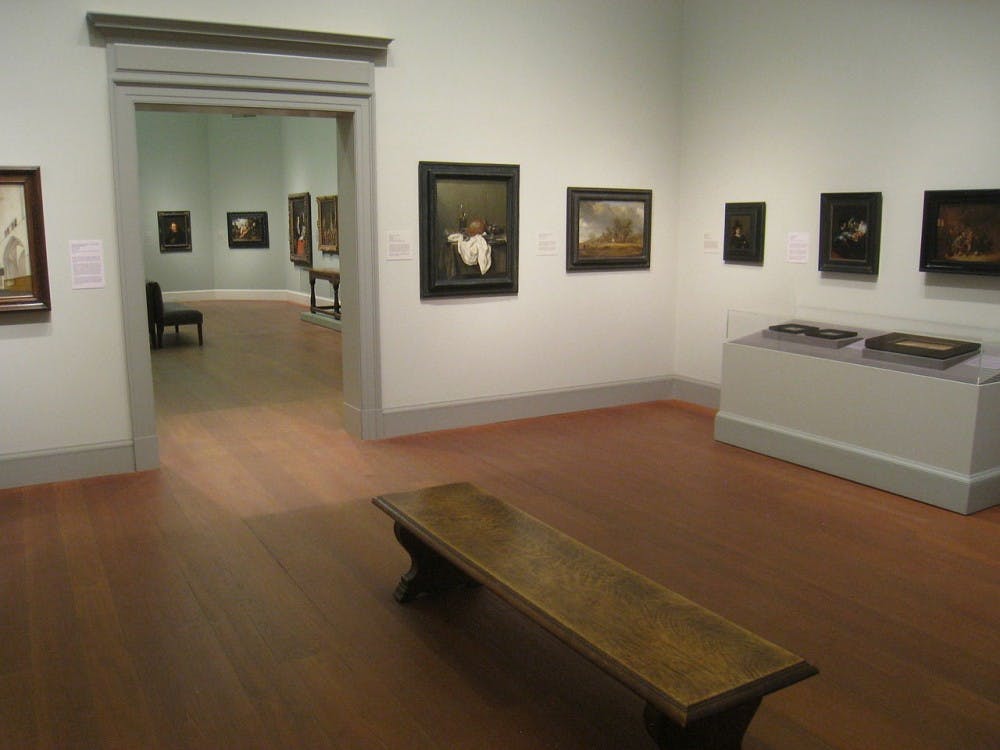So, you’ve decided to spend the day at an art museum, but you’re nervous about wandering about aimlessly, or even worse blending in and looking like a “mainstream hipster.” Street has you covered. Follow these key pointers to get your pseudo-intellectual on.
- Before you make your museum excursion, the first thing you must do is purchase a pair of glasses—preferably horn-rimmed, with a prescription slightly stronger than you actually need. Instead of having to fake a contemplative gaze throughout the visit, the stronger magnitude of the prescription will keep you squinting relentlessly, giving you the natural look of an art critic and connoisseur. Note: Ensure that these glasses fit your face correctly and that the lenses are not too large. When your lenses are too large you run the risk of looking like a “regular hipster.”
- Purchase a small, lined notebook, and a fresh ballpoint pen which you will occasionally pull out to take notes during your visit to the art museum. Moleskine journals are preferred, and extra points if you use a calligraphy set.
- Proper wardrobe choices are essential. The art museum is akin to a religious temple for pseudo-intellectuals such as yourself. Business casual attire and shined shoes will communicate your deep reverence for the artistic ambiance. Recall that this outing is more than a mere escape from the monotony of your nine-to-five. You seek intellectual stimulation. This is a visceral experience, you’re getting lost in artistic enrapture. Say “chiaroscuro.” Slowly.
- Upon entering the museum, the first thing you must do is purchase your tickets. When you approach the ticket counter, offer to purchase the ticket for your companion. This must be done gallantly. Say something along the lines of “Those seeking to expand their minds by exposing themselves to the timeless masterpieces and cultural icons housed in this fortitude of intellect, deserves to do so for free. Allow me to purchase your ticket. I look forward to our invigorating conversation and heated debates which the art will surely invoke.” Your pretentious diction and support for the arts will clearly distinguish you as an intellectual. Not to mention, your companion will be blushing with pride and false modesty at the compliment which you have just bestowed upon them. If you do not have a companion, do not fret. Simply say these lines to the person standing in line behind you.
- Before proceeding to admire the art, pick up a map and strategically plan your route. If neither Renaissance nor Medieval works sound enlightening, simply draw squiggly lines across the map. Your companion and any onlookers will be impressed by your intense intellectual curiosity and your pragmatic spirit.
- When viewing art, be sure to stand at least 25 paces away from the painting. If you cannot eye this distance, simply look around you and try to gauge the distance based on the positioning of the museum goers around you. Place your face in one palm and cross your opposite arm underneath it for support. Count to 15 inside of your head. Take ten paces forward, taking care not to step over any barriers which the museum has put in place to protect the artworks. Tilt your head to the left. Sigh contemplatively. Count to ten. Take ten steps backwards while humming quietly to yourself. Pause. Tilt your head to the right. Take off your glasses and fold them in your hands. Congratulations, you have successfully impressed (or alienated) your companion and all other museum-goers. If the room is now empty, you may proceed to enjoy the experience without the distracting murmur of ignorant visitors.
- If your companion is still present, gesture toward the painting with your whole hand (ensure you avoid pointing--this is a crude insult to the art and will make you appear blasphemously unrefined) as you describe symbolism, medium, and context. If there is no description on the side to guide your conjecture, merely fabricate an anecdote and utter the word “luminescence” between 3 and 5 times. No more, no less.
- If you simply cannot make sense of the piece, resort to this key phrase: “The title of the piece grossly detracts from the subject matter.” If you companion asks for an explanation, deadpan: “Exactly.”
- Alternatively, you may start a sentence with “This piece is just…” and trail off as you begin to ring your hands wildly and pace in small circles. Stop pacing after 15 seconds. You are an intellectual. You are not crazy. Take a picture of the work of art and pull the small notebook out of your book. Draw a smiley face and a house. This gives the impression that you have stumbled across something profound and are working hard to transcribe it. If anyone asks to see your notes simply say, “Oh no I couldn’t possibly show you until they are finished.” You can also simply stare at silence at the piece for a full two minutes longer and then murmur “I am at a loss for words” and walk away.
- If you cannot remember our prompts or following suggestions, simply turn on your heel and walk out of the museum. Tell your companion or any stranger that walks by that you were simply too moved by the piece you observed and had to leave. This trick works best if you have the ability to tap into painful childhood memories or memories of finals week and begin to cry.
- Assuming you executed steps six through nine, follow your pre-determined path through the museum until you reach the gift shop. It is absolutely essential to buy the most expensive item in the gift shop. I recommend buying one of the museum curators. They will frequently tell you that they are not for sale, but they are lying. Promise them that their new position in your home next your fanciest bookshelf will look great on their resume, and that you pay above minimum wage. Lie to them until you convince them to get into your car. This may feel strange, but I promise that intellectuals do this all of the time. It's called finding a summer intern.
Photo credit: Wikimedia commons







